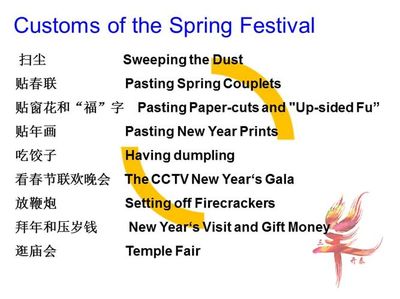The Spring Festival, also known as Chinese New Year, is the most important traditional festival in China,It is celebrated on the first day of the lunar calendar, which falls between January 21 and February 20 according to the Gregorian calendar.
The origins of the Spring Festival can be traced back more than 4,000 years to the Shang Dynasty,Legend has it that in ancient times, a mythical monster named Nian would come out of hiding on New Year's Eve to terrorize the villagers, devouring crops and livestock,To protect themselves, the villagers would put up red decorations, set off firecrackers, and light lanterns to scare away the monster.
Over time, these practices evolved into what we now know as the Spring Festival,It is a time for family reunions, feasting, and honoring ancestors,In the days leading up to the festival, people clean their houses to sweep away bad luck and make way for good fortune to enter,They also decorate their homes with red couplets, paper cuttings, and other auspicious symbols.
On New Year's Eve, families gather for a festive dinner known as the "reunion dinner." It is considered the most important meal of the year, and dishes with symbolic meanings are served,For example, fish represents abundance, dumplings symbolize wealth, and nian gao (a type of sticky rice cake) represents growth and success.
At midnight, firecrackers are set off to not only ward off evil spirits but also to welcome the New Year with a bang,The night sky is filled with colorful fireworks displays, which are believed to bring good luck and drive away bad fortune.
The first day of the New Year is reserved for visiting relatives, neighbors, and friends,It is customary to give red envelopes called "hongbao" to children and unmarried adults, as a token of good luck and blessings,The amounts of money inside the envelopes are usually even numbers, as odd numbers are associated with funerals,It is also common to exchange greetings and well-wishes, such as "Xin Nian Kuai Le" (Happy New Year) and "Gong Xi Fa Cai" (Wishing you prosperity).
During the Spring Festival, various traditional activities are organized to celebrate the occasion,Lion and dragon dances are performed, in which vibrant lion or dragon costumes are worn and dancers mimic the movements of these mythical creatures,The drums, cymbals, and other musical instruments create a lively atmosphere.
Another highlight of the Spring Festival is the Lantern Festival, which takes place on the fifteenth day of the lunar calendar,Thousands of lanterns are lit, creating a stunning visual spectacle,People also participate in lantern riddle guessing games and enjoy traditional performances, such as the lion dance and acrobatics.
The Spring Festival is not only celebrated in China but also in many other parts of the world with Chinese communities,It is a time when families come together, traditions are cherished, and hopes for the future are shared,It is a time to bid farewell to the old and welcome the new with joy and optimism.
In conclusion, the Spring Festival is a time-honored tradition that embodies the rich cultural heritage of China,It is a time for joy, reunions, and renewal,As the festival continues to evolve, it remains a cherished part of the Chinese cultural identity and serves as a reminder of the importance of family, friendship, and the pursuit of a prosperous and harmonious future.

The Spring Festival, also known as the Chinese New Year, is the most important traditional holiday in China,It is celebrated on the first day of the Chinese lunar calendar, usually falling between late January and early February,The festival has a history of over 4,000 years,It originated from the myth of Nian, a ferocious beast that would come out on the first day of the new year to attack people and livestock,To ward off Nian, people would put up red decorations, set off firecrackers, and stay up late on New Year's Eve,These traditions have been passed down through generations and are still practiced today,The Spring Festival is a time for family reunion, feasting, and paying respects to ancestors,It is also a time for exchanging gifts, expressing good wishes, and strengthening social ties,The festival lasts for 15 days, with various activities and celebrations taking place,The climax of the festivities is the Lantern Festival, which marks the end of the New Year celebrations,During this time, beautiful lanterns are displayed and colorful parades are held,In recent years, the Spring Festival has gained international recognition and has been celebrated in many parts of the world,It has become an important cultural event not only for the Chinese people but also for people of other nationalities,The Spring Festival is a time of joy, blessings, and new beginnings, symbolizing the hope and prosperity for the year ahead.
